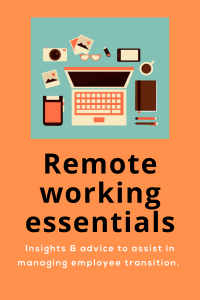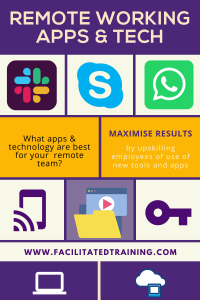The drive to working remotely is real. Here is how organisations can manage the transition.
According to a Feb. 25 notice from the Centres for Disease Control and Prevention (CDC), “Now is the time” for businesses to begin their preparation for the spread of COVID-19.
Preparation may need to include the expansion of employers’ capacity to offer remote work. “Businesses can replace in-person meetings with video or telephone conferences and increase teleworking or what is now more commonly referred to as remote working options,” says Colleen Condon, CLO, Facilitated Training.
“Regardless of the impact and spread of the virus, remote working will rapidly become the norm in many workplaces, not dissimilar to how women in the second world war went to work, and for the most part, didn’t leave at the conclusion of the war.”
To prepare for a period of mandated remote work employers need to develop and test work-from-home policies before they’re necessary.
Consider the following:
Identify roles and categorize roles that are key to operations, including those that can be conducted remotely.
Identify what is required for workers to successfully work remotely for example:
- Virtual private networks (VPN)
- Policy for reimbursement of items associated with the rapid deployment of remote working such as internet plans and mobile phone plans.
- Ergonomics for desk set up
- Help desk support
- Communication planning
- Training of remote tools and apps to increase the skills and effectiveness of working remotely.
- Will current technology be used, e.g. desktops, printers, desk phones? Is shipping them to workers homes more cost-effective than purchasing new laptops for example.
- Is it more cost-effective for the organisation to use its supply chain to organise equipment and technology requirements to be delivered to workers home, versus the impact of increased receipts, and reimbursements of employee purchases?
Your employees are part of the solution – so be sure to engage with them.
Consider deploying a test period of remote work. Identify roadblocks and engage your workers to identify possible solutions.
Employers can repeat this process throughout the entire organization, working through roles and departments according to their importance.
Be clear about preferred communications channels that replace desk conversations and meetings. Is it teams. zoom or something else entirely.
Chances are not all your employees will be app or tech-savvy, so be sure to schedule some remote training to set them up for success.
Apps and tools that may be useful to your business include:
Loom get your message across, no matter where you work https://www.loom.com/ Fellow.app It’s good at managing meetings, 1:1s, and continuous feedback https://fellow.app/
Miro a collaborative whiteboard https://miro.com/
Range for daily check-ins and meeting facilitation http://www.range.co
Triple for pair programming/problem solving https://tuple.app/
Shift any number of instances of software open at the same time in one place https://tryshift.com/
Slack collaboration tool, where People and the right Information come together. https://slack.com/
Asana manage all your projects and tasks in one place https://asana.com/
Zoom Video Communications for group and 1:1 video conferences and screen shares https://zoom.us/
SessionLab to collaborate and organize course content both for live/virtual sessions https://lnkd.in/f7PFGVT
Accessing the right tools and technology only solves half the issue of transitioning to remote working.
Leadership styles and communications need to adapt accordingly, commencing with increasing communications over multiple channels by at least 25% or more.
It is important for leaders and team members alike to consciously add in some kind of planned social interaction (besides business calls) in particular when you’re living alone. E.g. over lunch or a brief chat with a friend over a coffee. Social interaction/a feeling of inclusion is a fundamental human need and working remotely can feel like social exclusion as it removes random social interactions, e.g. a conversation at the coffee machine. Social exclusion, in turn, can affect cognitive function. There is a good reason that isolation is used as a punishment in prison systems. Make sure that you don’t inadvertently create this environment for yourself or your team.
Other tools that will assist in the transition to remote working include:
Without the constant interruptions of a busy office, remote workers often forget to take enough breaks. That’s not good for the eyes, the back, the brain or the soul. Take a Break, Please is a simple but potentially life-changing app that reminds you to do so.
- Continuing to be physically active is key to both mental and physical health. One option is to consider using an online gym Gymondo comes as an app with diverse classes and progress tracking. https://www.gymondo.com/en
- Engagement is key to a happy and productive team. Consider creating a team Tik Tok channel for random fun.
- Others new to remote working may find the lack of ‘white noise’ a hurdle to overcome. Lo – fi background music can solve this issue. Try listening to a playlist like this:
Similarly, background music or ‘ambient tunes’ for the hip, can be found on Youtube readily for free.
For many, remote working is not new. Utilise the knowledge and skills you have within your organisation to help those, that it will be.
Expect disruptions, from impacts to workers who are sick, or have sick family members. Coach and support those who would prefer to work in an office environment (for some it’s an escape!). But most of all adapt and communicate more with your colleagues and team members. In the absence of information and proactive communication, we humans make up our own information. In an environment that is already full of unknowns regarding sickness and the availability of toilet paper (for some), reduce the level of anxiety by increasing your communication.
In our next post, we will be discussing the benefits & challenges to both employees and employers regarding remote working and virtual teams.
_______________________________________________________________________________
Does your organisation need a training pack to assist in the transition to remote working? Facilitated Training has you covered. An editable training pack will be launching in the very near future. It will save time and money in developing content, so your organisation can increase communications and people engagement.
For more information, checklists, and references to assist in the transition to working remotely for team members and leaders will be posted in the following days.
What tips and insights can you share to assist in the transition – be it permanent or short term? Let us know in the comments below.
——————————————————————————————————————————
Targeted, professional development courses enable you to deliver effective training sessions that get the key message across and retain participant involvement.
- Save hours of research and development time. We have done all the hard work so you can focus on the training delivery
- Own complete rights to edit, copy, and reuse the training materials. You can even brand it with your business logo and name.
- Download all training courses and course-ware packages immediately in their source files.
Each training course includes:
- Detailed Trainers / Facilitator Guide
- Targeted explainer video
- Learner Workbooks
- Adult centred training activities
- A self-paced learning plan for learning application back in the workplace
- Learner Attendance Certificate
- Attendance record
- Training evaluation sheet
Facilitated Training has the solution that you need. Editable training materials that can be used again and again. Insert your company logo, add in case studies or examples from your workplace, or train using the quality training materials, as is.
Facilitated Training is your one-stop-shop for world-class, customizable training and professional development resources.
Facilitated Training offers training and organisational development resources to facilitators, trainers, coaches, HR managers and individuals.
Specialising in customisable leadership and management skills, Facilitated Training features a wide variety of products, including Training resources, Professional development courses, assessments, ebooks, videos and more.
Click here for customisable training materials that will assist your workplace in managing resources and output.
www.facilitatedtraining.com
About the author: Colleen Condon
Colleen likes to keep things creative in all that she does, often using marshmallows as a source of inspiration.
Everyone knows that ongoing learning is essential for both personal and professional success and yet, for many, this means hours of attending dead boring training or completing’ losing the will to live’ eLearning modules. Colleen’s mission is to end tedious professional development while ensuring targeted outcomes for learners and businesses.
Colleen has honed her skills over the last 20 years across multiple industries and locations. Her previous role saw her overseeing the training and development needs of over 60, 000 employees across 13 countries in the APAC region. This enabled her to hone skills that celebrated diversity and understanding human commonality through learning, and that in the absence of a common language, flip charts and coloured markers helped her to overcome most challenging situations.
After taking a ‘go away package’, in 2019, Colleen founded her own business, Facilitated Training, harnessing her global learning experiences and sharing them through ready to use learning resources, specialising in leadership, mentoring, guest speaking, creative problem solving, filling the gap of high quality, customisable training resources and tools.
#WFH
#remoteworking
#whitelabel
#facilitatedtraining


